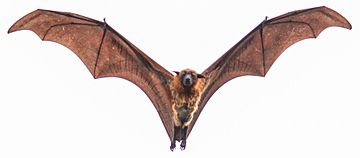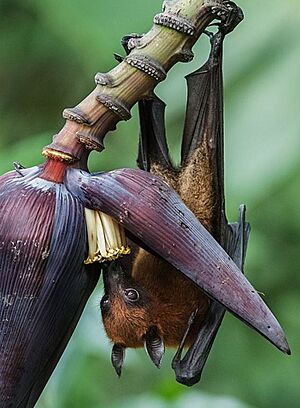Indian flying fox facts for kids
Quick facts for kids Indian flying fox |
|
|---|---|
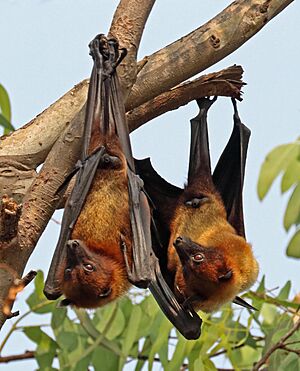 |
|
| In Jamtra, Madhya Pradesh, India | |
| Conservation status | |
| Scientific classification | |
| Genus: |
Pteropus
|
| Species: |
medius
|
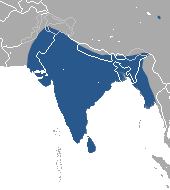 |
|
| Range | |
| Synonyms | |
|
|
The Indian flying fox (Pteropus medius), also known as the greater Indian fruit bat, is a type of flying fox found in the Indian subcontinent. It is one of the biggest bats in the world. These bats are important because they can carry certain germs that might spread to humans.
Indian flying foxes are active at night. They mostly eat ripe fruits like mangoes and bananas, and also drink nectar from flowers. Sometimes, farmers see them as pests because they eat fruit crops. However, these bats also help plants by spreading pollen and seeds, which is very helpful for nature.
Contents
About the Indian Flying Fox
The Indian flying fox was first described by a Dutch zoologist named Coenraad Jacob Temminck in 1825. He gave it the scientific name Pteropus medius. For a long time, people also called it Pteropus giganteus.
In 2012, a scientist named Mlíkovský suggested that Pteropus medius is the correct scientific name. This is because of a rule called the Principle of Priority. This rule says that the first proper scientific name given to a species should be the one used. Since the name Pteropus giganteus was first used for a different bat that already had a name, Pteropus medius became the oldest correct name for the Indian flying fox. Some scientists now use Pteropus medius, while others still use Pteropus giganteus.
The Indian flying fox is closely related to the grey-headed flying fox. It belongs to a group of bats called the vampyrus species group. This group includes many other flying foxes like the large flying fox and the Rodrigues flying fox.
There are three known types (or subspecies) of the Indian flying fox:
- P. m. ariel
- P. m. medius
- P. m. leucocephalus
Family Tree
|
|||||||||||||||||||||||||||||||||||||||||||||
| How the Indian flying fox is related to other flying foxes (from a 2014 study) |
What Does it Look Like?
The Indian flying fox is the largest bat in India and one of the biggest bats in the world. It can weigh up to 1.6 kilograms (about 3.5 pounds). Males are usually bigger than females.
Its wingspan, which is the distance from one wingtip to the other, can be between 1.2 and 1.5 meters (about 4 to 5 feet). Its body length is about 15.5 to 22.0 centimeters (about 6 to 8.5 inches). Its wings attach to its back and to its second toe. It has strong claws on its thumbs and on the first two fingers of its wings. It also has claws on all five toes of its feet. This bat does not have a tail.
The Indian flying fox has a black back with some grey streaks. It has a pale, yellowish-brown "mantle" (a cape-like area around its shoulders). Its head is brown, and its underside is dark brownish. It has large eyes and simple ears, which is typical for bats in the Pteropus group. Its ears are about 35-40 millimeters long.
These bats have a special set of teeth. They have large, pointed canine teeth. The longest recorded lifespan for this type of bat in captivity was over 31 years.
Where Do They Live?
The Indian flying fox lives across the Indian Subcontinent. This includes countries like Bangladesh, Bhutan, India, Tibet, the Maldives, Myanmar, Nepal, Pakistan, and Sri Lanka.
They like to sleep (or roost) in large groups called colonies. They often choose open tree branches, especially in cities or near temples. They prefer tall trees with thin trunks, particularly those with a lot of leaves at the top. They also like to be near water, human homes, and farms. This is because they can easily find food in these areas. For example, many homes have gardens with fruits they like to eat.
Their homes are often threatened when cities grow or roads get wider. Trees where they roost are sometimes cut down, forcing the colonies to move. Smaller colonies tend to stay in their roosts longer than larger ones.
Daily Life and What They Eat
Indian flying foxes sleep together in large groups in the treetops of big trees. These groups can have thousands of bats. They often use the same roosting spots for many years, staying there all year round.
While resting, the bats often chatter and argue. On sunny days, they fan their wings. On cloudy days, they are quiet and wrap their wings around themselves. A few bats might fly around during the day, but most activity happens at night. They leave their roosts one by one about 20-30 minutes after sunset. Bats at the top of the roost usually leave first. The time they leave depends on how long the day is, the sunset, and the air temperature.
When they fly out, they look like a big swarm, but they search for food on their own. They can fly up to 93 miles (about 150 kilometers) to find food, using their good eyesight. They can quickly move up and down tree branches to find fruit.
Diet
The Indian flying fox is a fruit-eater or nectar-drinker. This means they eat fruits or drink nectar from flowers. At dusk, they look for ripe fruit. They are not picky eaters and will eat any fruits they can find.
When they eat fruit, the seeds pass through their bodies and are spread through their waste. This helps new plants grow. They help spread seeds for about 300 different plant species. Many of these plants produce valuable products in India. For example, nearly 70% of the seeds in their waste are from the banyan tree, which is a very important tree in Indian ecosystems.
Even though people thought they only ate fruit, they have been seen eating insects and leaves too. They also eat flowers, seed pods, bark, cones, and twigs. Their diet changes with the seasons. For example, they eat more mangoes in autumn and spring for moisture. They rely on other trees like the pale moon ebony tree for fiber all year. In winter, they get important nutrients from yellow box eucalyptus and Chinese pistache trees.
Reproduction and Life Cycle
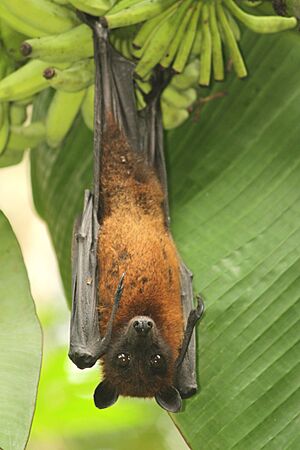
Indian flying foxes breed once a year, usually from July to October. Baby bats are born between February and May. Pregnancy lasts about 140 to 150 days. A mother usually gives birth to one or two pups.
Young bats stay with their mother for the first few weeks of their lives. They stop drinking their mother's milk around 5 months old. Male bats do not help raise the young. Baby bats learn to fly when they are about 11 weeks old. They can start having their own babies when they are 18 to 24 months old.
Indian Flying Foxes and People
Germs and Health
Like other fruit bats, Indian flying foxes can carry certain germs, including some viruses. These germs can sometimes make humans or farm animals sick. Indian flying foxes in India and Bangladesh have been found to carry a virus called Nipah virus. Because people are building homes closer to bat habitats, there's a chance these germs could pass from bats to humans.
It's important to know that just having bats nearby doesn't mean you'll get sick. A big way the Nipah virus has spread is through drinking date palm sap. People collect this sap from date palm trees. Indian flying foxes have been seen licking the sap as it flows into collecting pots. If people drink this sap, they might be exposed to the virus. Using bamboo covers on the collecting pots can help prevent bats from touching the sap.
As Pests to Farmers
Some people consider the Indian flying fox a pest because they eat ripe fruit from orchards. One study in India found that these bats caused the most damage to mango and guava crops. However, about 60% of the fruit they damaged was already very ripe or overripe, which is less valuable to farmers.
In the Maldives, Indian flying foxes are seen as major pests of almond, guava, and mango trees. Sometimes, bats have been killed to protect orchards. But there are other ways to protect fruit. Farmers can put nets over trees to keep bats away. They can also harvest fruit quickly so there's less ripe fruit to attract bats. Other ideas include using loud noises, special chemicals, or lights at night to scare bats away. Planting Singapore cherry trees near an orchard can also help, as flying foxes prefer their fruit over many other crops.
Traditional Uses
In Pakistan, the number of Indian flying foxes has gone down. This is partly because some people believe that the bat's fat can help treat rheumatism (joint pain). In the Attappadi region of India, some tribes eat cooked Indian flying fox meat to treat asthma and chest pain. Healers from the Kanda Tribe in Bangladesh use bat hair to make treatments for "fever with shivering."
In Pakistan and India, Indian flying foxes are more often killed for these traditional medicines than for food, even though scientists say these methods don't work. However, some indigenous tribes in India do eat the meat. The meat is sold in small local markets and is not a big part of the economy. Some researchers believe that hunting might not be the biggest problem for these bats. Instead, losing their homes and being disturbed in their roosts might be more harmful to their populations.
In Culture
Even though the Indian government lists bats as "vermin" in the Wildlife Protection Act, 1972, the Indian flying fox is considered sacred in some parts of India. In the village of Puliangulam, a banyan tree in the middle of farm fields is home to about 500 Indian flying foxes. The villagers believe a local spirit named "Muniyandi" protects the bats. They offer bananas and rice to the spirit and the bats.



